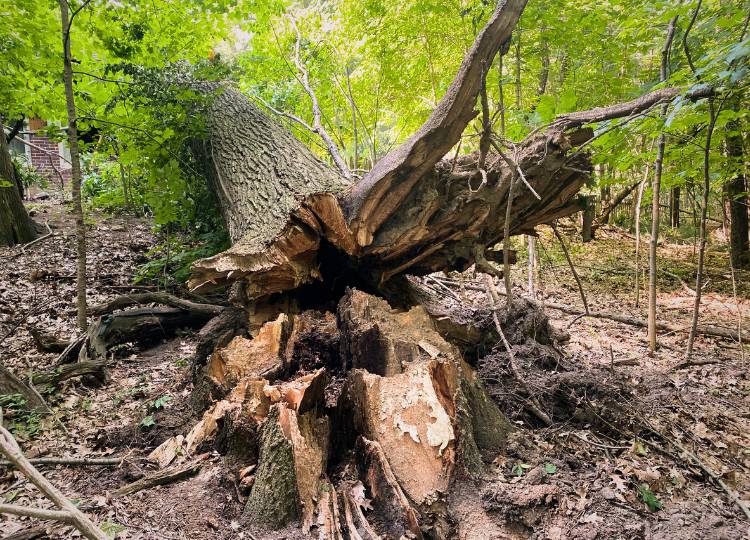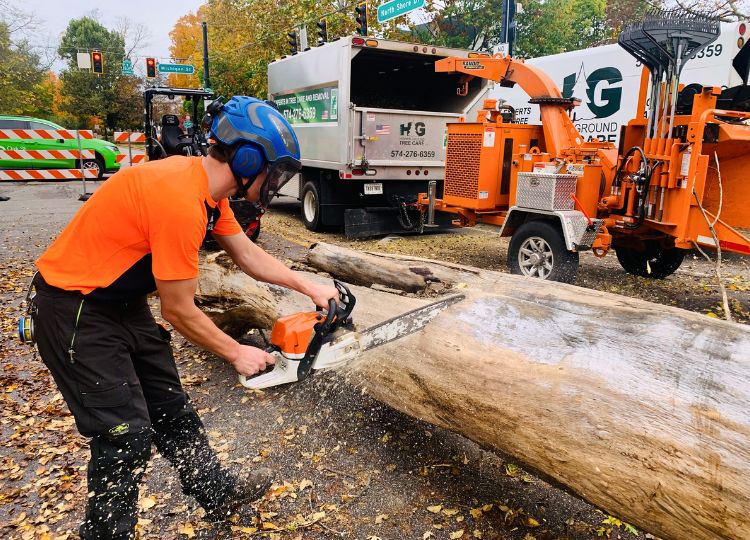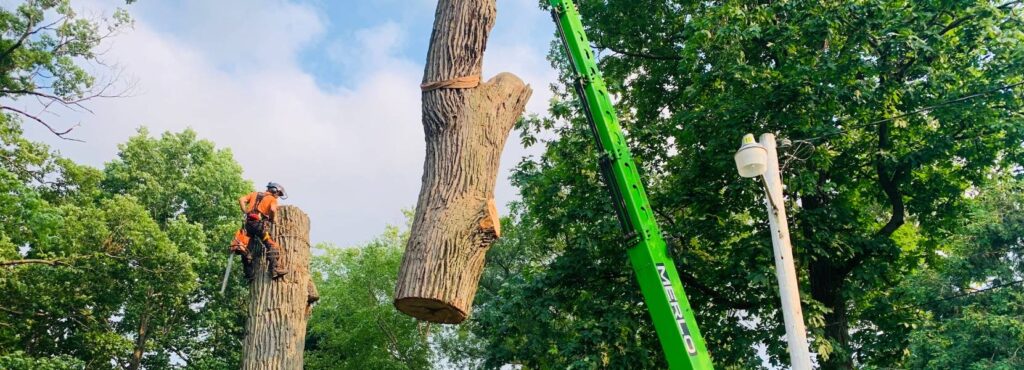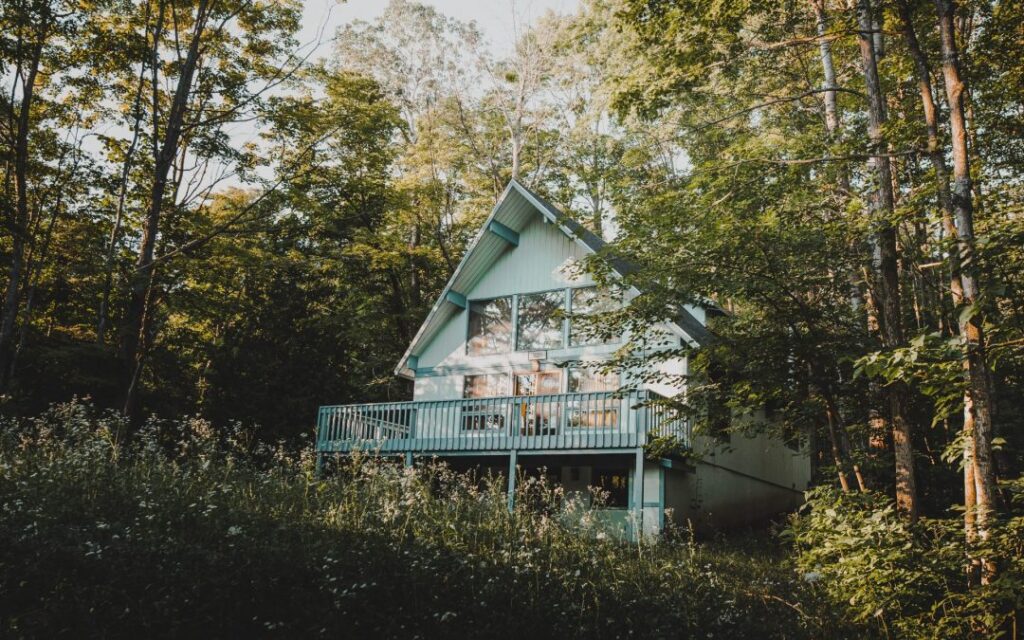Signs It’s Time to Remove a Tree from Your Michiana Yard
Learn when to remove trees in Michiana. Discover the key signs of tree problems, common reasons for removal, and alternatives to tree removal.
Deciding to remove a tree from your yard or commercial property isn’t easy. Trees add beauty, shade, privacy, and energy savings to our homes. But sometimes, keeping a tree might cause more problems than benefits.
Whether it’s because of disease, damage, or simply outgrowing its space, removing a tree is a big decision. Knowing when it’s the right time can help protect people, buildings, and other trees. Let’s look at when it might be best to take a tree down.
Key Takeaways
- Dead, diseased, or structurally damaged trees pose significant safety risks and should be removed promptly to protect people and property.
- Overcrowded trees or those with visible decay may need removal to promote the health of surrounding vegetation and prevent potential hazards.
- The location of a tree, its environmental impact, and its effects on energy savings should be considered before deciding on removal.
- Professional arborists have the expertise and equipment to safely assess, remove, or treat trees while ensuring legal compliance.
- Alternatives to tree removal such as pruning, pest management, and root services may be viable options for maintaining tree health and safety.
Common Reasons for Tree Removal in Michiana
Here are some of the most common reasons why we remove trees in the Michiana area.
Dead or Dying Trees
A dead or dying tree can quickly become a problem in your yard. Once a tree is no longer healthy, its branches can start to break off, and the whole tree might even fall during a storm. This puts people, pets, and property at risk.
In Michiana, weather is unpredictable. In the South Bend area, we have as many as 42 thunderstorm days a year. During the summer storm season, a dead tree can be especially dangerous. Removing it quickly not only prevents accidents but also makes space for a new, healthy tree to grow in its place.
Disease or Pest Infestation
In our area, trees can easily get diseases or pests that weaken them over time. Common issues like emerald ash borer infestations or fungal infections can spread quickly, affecting not just one tree but also nearby plants.
If a tree has a bad infestation or disease, it might be beyond saving (especially with emerald ash borers) and could risk harming the surrounding landscape. Removing the tree helps stop the spread and protects the rest of your yard from further damage.

Structurally compromised trees are more likely to fail in a storm.
Structural Damage
Storms, high winds, or even construction work can damage a tree’s structure, making it unstable. A tree that has lost large branches or has a cracked trunk is more likely to fall unexpectedly.
Here in our area, severe weather can happen year-round, and a damaged tree can be a serious safety concern. Removing a structurally damaged tree is often the safest option to prevent potential accidents and damage to your property.
Depending on the extent of the damage, structural support options may be available to help hold your tree together. Call us at 574-276-6359 to see if we can save your Michiana tree.
Overcrowding
Sometimes, young trees that are planted too close together start to compete for sunlight, water, and nutrients. This can lead to stunted growth for all of them. It can also increase the spread of fungal infections or pest problems.
In Michiana yards, where space might be limited, overcrowded young trees can also grow unevenly or become weak. Removing one or more trees can help the remaining ones grow stronger and healthier, ensuring they have enough space and resources to thrive.
Mature trees, on the other hand, grow to rely on each other when in a tight-knit group, and removing one may have a negative impact on the others. A professional arborist can help decide which trees to remove and which to keep based on age, size, and a number of other factors.
Visible Decay or Fungi Growth
If you see mushrooms or other fungi growing at the base of a tree, it often means the tree is decaying inside. This kind of decay weakens the tree from the inside out, making it more likely to fall.
Heavy rains and snow can add extra stress to trees, making decay especially dangerous. Removing a tree with significant decay can prevent potential damage to your property and keep your yard safe.
Factors to Consider Before Removing a Tree
Before deciding to remove a tree, it’s important to think about several factors to make the best choice for your yard and the environment. Here are some key considerations:
Tree’s Location
- Proximity to Buildings: If a tree is too close to your home, garage, or other structures, it can cause significant damage if it falls or drops branches. Tree branches growing near the roof or siding of a home can also increase the chances of pests getting inside.
- Power Lines: Trees growing near power lines can be dangerous. Branches falling on lines can cause outages for entire streets or neighborhoods. Trees too close to main lines may need to be removed to prevent electrical hazards, while those near secondary lines might benefit from regular pruning to keep them at a safe distance.
- Sidewalks and Driveways: Roots can lift and crack concrete, roads, pavers, and other hardscapes, creating hazards and potentially costly repairs. Removing or managing the problem tree may be the most cost-effective solution in the long run.
The Impact of Lost Trees
There’s always a cost when it comes to tree removal. Here are some of the downsides to consider as well when removing a tree:
- Loss of Shade and Wind Protection: Removing a tree might affect the comfort of your home and yard due to a loss of shade and wind protection.
- Energy Savings: Trees that provide shade can significantly lower cooling costs in the summer by blocking direct sunlight, and windbreaks can help reduce heating costs in the winter by shielding your home from cold winds. Removing these trees might contribute to higher energy bills.
- Noise Pollution: Trees help minimize noise pollution. Removing them could allow more noise to reach your yard and home.
- Loss of Privacy: Consider what’s behind the tree you want to remove. You might think twice if it’s road, parking lot, or a view of your neighbor’s living room.
- Wildlife Habitat: Trees provide homes for birds, squirrels, and other wildlife. Removing a tree may disrupt local ecosystems, leading to the loss of important habitats and affecting the biodiversity in your yard and local community.
- Carbon Footprint: Trees absorb carbon dioxide and release oxygen, helping to reduce your carbon footprint. Consider whether removal is necessary or if the tree can be saved through other means, such as pruning or treatment, to continue benefiting the environment.

The Importance of Professional Tree Removal
When it comes to tree removal, hiring a professional is the best choice. Certified arborists have the knowledge and equipment to handle the job without risking injury or property damage. Here are just a few reasons that professional removal is a must:
- Expert Assessment: Professionals can accurately assess the tree’s condition and determine the safest and most effective removal method. If a tree can be saved, they’ll help to preserve it.
- Proper Equipment: They have specialized tools and machinery to handle any size tree, ensuring a smooth and safe removal process.
- Safety First: Professionals are highly trained, reducing the risk of injury or costly damage to your property.
- Avoiding Hidden Issues: They can identify and address potential problems that may not be obvious to the untrained eye.
- Thorough Cleanup: After removal, professionals ensure your yard is clean and free of debris, including handling stump grinding if needed.
- Legal Compliance: Professionals are aware of local regulations and can ensure that the removal is done in compliance with any necessary permits.
Trusting experts ensures the job is done right, giving you peace of mind and a safe, well-maintained yard.
Alternatives to Tree Removal
Just because a tree is struggling or at risk doesn’t mean we need to jump straight to removal. There may be a few other options that a professional arborist can use to increase the chances of tree success. Here are some of those options, and when an arborist might consider them:
- Pruning: Removing dead, diseased, or overgrown branches can improve a tree’s health and stability. Pruning can reduce the risk of falling branches and help redirect the tree’s energy toward healthier growth.
- Pest and Disease Management: Addressing pests or diseases early can prevent them from spreading and causing severe damage to the tree. An arborist may use treatments like insecticides, fungicides, or other targeted interventions. Treatment is ideal when a tree shows early signs of infestation or disease but is still strong enough to recover. Ultimately, pest prevention is the best way to keep trees healthy and safe long-term.
- Tree Cabling and Bracing: Tree preservation services, like installing cables and/or braces, can provide extra support to weak or structurally compromised trees. This technique helps reinforce the tree’s structure, reducing the risk of collapse. It’s particularly useful for trees that are healthy overall but have a weak limb or a split trunk that needs extra support to stay standing.
- Root Services: Addressing issues with a tree’s root system can be important for its survival. Root crown excavation can expose problematic roots and decay issues at the base of a tree. Root pruning can remove problematic roots that are causing, or have the potential to cause, damage.
These alternatives can often save a tree that might otherwise be considered for removal, helping to preserve the beauty and benefits it provides to your yard for a few more years, or even decades.
Making the Right Choice for Your Trees
Removing a tree is a significant decision that requires careful consideration of various factors. From assessing the tree’s health to exploring alternative solutions, it’s important to make an informed choice.
Whether you need tree removal, treatment, or professional advice, our team is here to help. Call us at 574-276-6359 for an inspection and a tree removal estimate today.




